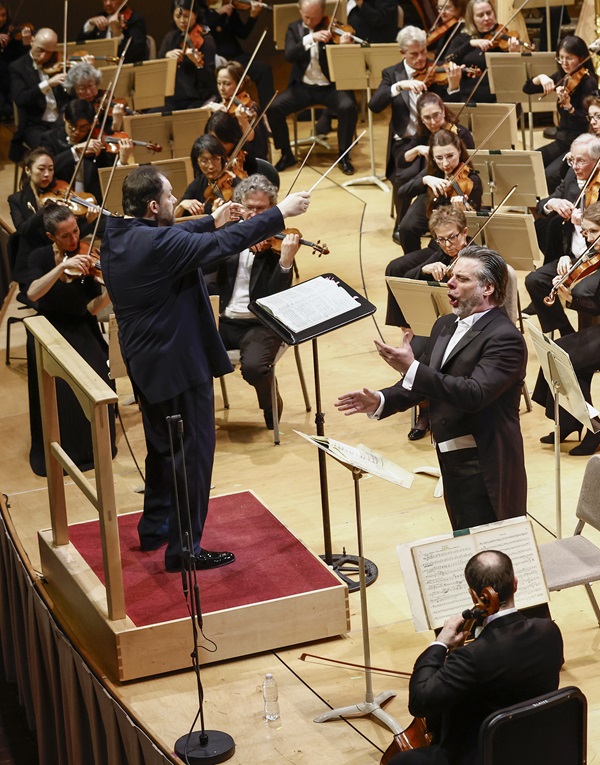Shakespeare’s star-crossed lovers sink in ponderous Berlioz from Nelsons, BSO

Andris Nelsons conducted the Boston Symphony Orchestra and bass John Relyea in Berlioz’s Roméo et Juliette Thursday night. Photo: Winslow Townson
The combination of Hector Berlioz and William Shakespeare is a match made in heaven. The French composer didn’t just take passing inspiration from the works of the Bard. Rather, in them, he discovered the voice of a kindred spirit that, in turn, found a glorious outlet in his music.
For their part, the Boston Symphony Orchestra is often an ideal vehicle for Gallic musicians, especially Berlioz. The ensemble has a long history with French repertoire and certain of its recordings of this composer’s work (like the Symphonie fantastique under Charles Munch) are benchmarks.
However, there was little sense of familiarity, let alone interpretive mastery, to be had in Thursday night’s season-ending account of the Romantic icon’s Roméo et Juliette at Symphony Hall. Instead, the performance revealed a conception of this peculiar work from BSO music director Andris Nelsons that might charitably be described as “in progress.”
Less magnanimously, Nelsons’ approach seemed at times fundamentally at odds with the spirit and letter of the music: tedious and lacking in the essentially Berlioz-ian qualities of style and definition.
True, Roméo et Juliette is hardly the perfect opus. A sprawling program symphony, Berlioz’s 1839 score provides a summary of Shakespeare’s play through a series of recitatives, arias, choruses, and instrumental meditations. At times it rambles and seems to digress.
Yet spots of it are visionary, anticipating Britten and Berg by a century or so. The handling of the orchestra is astonishingly fresh. For sweep and character, Berlioz never exceeded Roméo in any of his symphonic music, even the Symphonie fantastique.
To come off in concert, what it needs, more than anything, is an electrifying sense of direction and clear illumination of its structure. Thursday’s performance, though, was frequently slack.
Even so, some of the music’s novel aspects managed to surface. The openings of “Romeo alone” and the Balcony Scene, for instance, were breathtakingly inward. The glassy sonorities of the “Queen Mab” scherzo’s Trio rang with becoming weirdness, and the orchestra affectingly etched the lovers’ demise in the Capulet tomb.
Mostly, though, Roméo’s expressive heart was muffled.
Both the Introduction’s counterpoint and the quicksilver figurations in “Queen Mab” sounded ragged. The evocation of Roméo’s melancholy state in Part 2 was tonally beguiling but missing crucial tension. Despite a vigorous beginning, that section’s depiction of the Capulet ball became more and more leaden as it proceeded: its zenith built to a din, not a whirling frenzy.
One of the night’s fundamental issues was pacing: Nelsons’ rendition of this 95-minute-long score was stretched, on Thursday, to an ungodly (and intermission-less) 110. Unsurprisingly, Roméo’s architecture sagged.
Nowhere was the phenomenon more keenly felt than during Part 3, when the conductor’s penchant for broad tempos drained all the life out of Berlioz’s portrayal of the young couple in love. What emerged was aimless and, except for a belated surge of passion just before the end, emotionally sterile.
Ditto for the night’s interminably slogging, though dynamically well-sculpted, account of Juliette’s funeral procession.
Surprisingly, given the reading’s paucity of ardor and impishness, Thursday featured some of the BSO’s most refined playing for Nelsons all season. Their dynamic range was enormous. Textures were nearly always lucid. The blend of woodwinds was exquisite, especially in the Balcony Scene. Brasses, too, were kept admirably under control, and the balance between harps, winds, and cellos in Part 1’s Strophes left little to be desired.
Making their BSO subscription series debuts, mezzo-soprano J’Nai Bridges and tenor Nicholas Phan imbued their brief turns with warmth and élan. Though singing essentially bit parts, the combination of Bridges’ bronzed opulence and Phan’s brash vitality left strong impressions. Let’s have them back soon.
Also compelling was bass John Relyea’s commanding tone and infinite reservoirs of volume. His account of Friar Laurence’s aria and injunction for reconciliation between the warring families rang with stentorian majesty, even managing to project above the chorus and orchestra going at full tilt.
For their part, the Tanglewood Festival Chorus dispatched the grandiose moments in Part 4 with radiant energy and good diction. Smaller groups in Parts 1 and 2 periodically sounded scrawny, though their pitch and enunciation were perpetually true.
The program will be repeated 1:30 p.m. Friday and 8 p.m. Saturday at Symphony Hall. bso.org
Posted in Performances